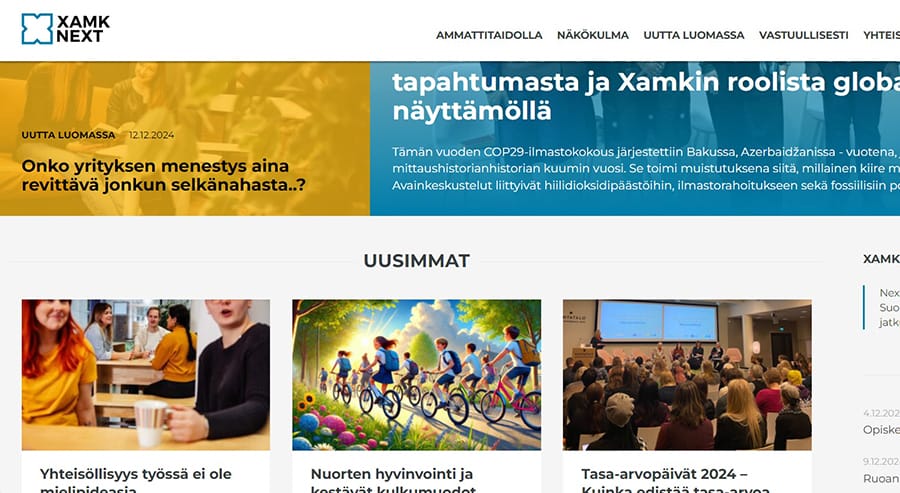Overcoming the challenges of learning by utilizing AI
We aim to master more digital tools and engage students with an increasing amount of options also for distant learning. In order to design study-friendly virtual courses, we need to keep in mind also the most dominant problems causing student drop-outs in these environments:
- lack of incentive
- failure to understand the content material and
- having no one to turn to for help. (Hew & Cheung 2014 and Budash & Shaw 2017).
In November 2017 I participated an education export event organized by Helsingin Ekonomit, where DSc (Econ.) Lauri Tuomi, Programme Director at Finnish National Agency for Education, forecasted that intelligent learning platforms such as Claned will in the future take over current platforms of Moodle and the like.
How can intelligent learning platforms help?
Intrigued by this statement, I decided to make some detective work on what these intelligent learning platforms are and how could they help us in designing more efficient teaching and overcome the underlying challenges of students especially in distant learning environments.
I had the opportunity to visit one provider of “smart” digital learning environments, Claned®, in Helsinki in December 2017, and discuss with the personnel how artificial intelligence and collaborative learning can help individuals and organizations remove barriers to digital learning, improve study engagement and learning results. Here some key points that can give us food for thought in taking the next step in developing digital learning environments:
- Social interaction and intuitive user interface. Modern learning environments can have over 10 times more interaction than their old-style companions due to having social interaction integrated as part of the learning material and not separate. The student can see the pictures of other participants and participate in a chat immediately on the landing page, and have the opportunity to ask questions not only from teachers but from other students as well. The environment is also designed in a way that resembles other social media applications, and is therefore naturally familiar in functions for the user. According to Casey & Kroth (2013) and He (2014), consistency and clarity in the organization of course tools and materials is important as it lessens the cognitive load for learners.
- Objective setting. Initially, the platform can ask the student what is the level of knowledge that the student wishes to achieve on this topic and help in setting the objective: whether it is e.g. just to pass the course or become an expert on the matter. Based on this, the learning path, materials and tasks can be automatically adapted.
- Directing the student. The learning platform can keep track of what content the student has not only opened but actually studied and suggest further readings on those topics. This can be the material that the teacher has uploaded, but also anything else available e.g. in other courses in the platform or elsewhere in the internet. The technology learns from the user’s behavior.
- Visualization. The landing page of a course can show a visual of the learning path, which can be different to each student.
- Capturing of data. Interactions occur when learners read, write, collaborate, organize and plan – and the platform can register all of it. This results in a comprehensive insight that demonstrates the learners’ study performance and learning orientation, but also motivation, emotion and stress levels. Modern tools can actually help students to develop an understanding on how they learn, as artificial intelligence can reveal factors that impact individual learning.
- Acting before drop-outs happen. Based on the insights from the previous step, instructors can receive the necessary tools to intervene before failure or drop-outs occur, as well as assistance in recognizing learners needing support or lacking challenge.
- Collaborative knowledge creation and discussion. Without having to use any separate authoring tools, the students can create, publish and organize learning content from different sources – publishers, professors and other students. This content is recommended to students based on multiple identified factors including skill-levels and learning orientation. Claned for example also allows students to share their own notes, papers and projects to other students. This complementary content might be crucially important to clarify any difficult points in the official study material. As Claned algorithms analyze user interactions, it is able to connect learners with each other and study buddies and groups for peer support. (Claned and the author 2017).
The key of the modern day digital learning environments seems to be that they are not there just to administer the content and the students, but instead actually provide the teachers and students themselves with some extra muscles to support learning. As the strategy of Xamk is to be in the forefront of digitalization and provide new learning technologies together with personalized learning paths, we should lead with example and evaluate how we can apply such forward-looking thinking in our course design. And can we also utilize AI in order to boost the learning experience?
Sources:
Budash, Deborah and Shaw, Melanie: Persistence in an Online Master’s Degree Program: Perceptions of Students and Faculty. Online Journal of Distance Learning Administration, Volume XX, Number 3, Fall 2017. University of West Georgia, Distance Education Center.
Casey, R. L., & Kroth, M. (2013). Learning to develop presence online: Experienced faculty perspectives. Journal of Adult Education, 42(2), 104-110.
Claned – your personal learning environment. Brochure from the company. 2017.
He, Y. (2014). Universal design for learning in an online teacher education course: Enhancing learners’ confidence to teach online. MERLOT Journal of Online Learning and Teaching, 10(2), 283-298.
Hew, K. F. and Cheung, W. S.: “Students’ and instructors’ use of massive open online courses (MOOCs): Motivations and challenges,” Educational Research Review, vol. 12, pp. 45-58, 2014.
Tuomi, Lauri. Programme Director, Education Finland growth program, Finnish National Agency for Education. 14.11.2017.
Raivonen,Petra. Project Manager, Claned. 5.12.2017.
Picture credits: Claned 2018.




